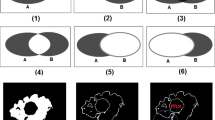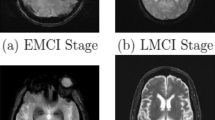Abstract
M-reps (formerly called DSLs) are a multiscale medial means for modeling and rendering 3D solid geometry. They are particularly well suited to model anatomic objects and in particular to capture prior geometric information effectively in deformable models segmentation approaches. The representation is based on figural models, which define objects at coarse scale by a hierarchy of figures—each figure generally a slab representing a solid region and its boundary simultaneously. This paper focuses on the use of single figure models to segment objects of relatively simple structure.
A single figure is a sheet of medial atoms, which is interpolated from the model formed by a net, i.e., a mesh or chain, of medial atoms (hence the name m-reps), each atom modeling a solid region via not only a position and a width but also a local figural frame giving figural directions and an object angle between opposing, corresponding positions on the boundary implied by the m-rep. The special capability of an m-rep is to provide spatial and orientational correspondence between an object in two different states of deformation. This ability is central to effective measurement of both geometric typicality and geometry to image match, the two terms of the objective function optimized in segmentation by deformable models. The other ability of m-reps central to effective segmentation is their ability to support segmentation at multiple levels of scale, with successively finer precision. Objects modeled by single figures are segmented first by a similarity transform augmented by object elongation, then by adjustment of each medial atom, and finally by displacing a dense sampling of the m-rep implied boundary. While these models and approaches also exist in 2D, we focus on 3D objects.
The segmentation of the kidney from CT and the hippocampus from MRI serve as the major examples in this paper. The accuracy of segmentation as compared to manual, slice-by-slice segmentation is reported.
Similar content being viewed by others
References
Amenta, N., Bern, M., and Kamvysselis, M. 1998. A new Voronoibased surface reconstruction algorithm. Computer Graphics Proceedings, Annual Conference Series, 1998, ACM SIGGRAPH: 415–422.
Attali, D., Sanniti di Baja, G., and Thiel, E. 1997. Skeleton simplifi-cation through non significant branch removal. Image Processing and Communications, 3(3/4):63–72.
Bittar, E., Tsingos, N., and Gascuel, M. 1995. Automatic reconstruction of unstructured 3D Data: Combining a medial axis and implicit surfaces. Computer Graphics Forum (Eurographics' 95), 14(3):457–468.
Blum, H. 1967. A transformation for extracting new descriptors of shape. In Models for the Perception of Speech and Visual Form.W. Wathen-Dunn, (Ed.). MIT Press: Cambridge MA, pp. 363–380.
Burbeck, C.A., Pizer, S.M., Morse, B.S., Ariely, D., Zauberman, G., and Rolland, J. 1996. Linking object boundaries at scale: A common mechanism for size and shape judgments. University of North Carolina, Computer Science Department, Technical Report TR94–041. Vision Research., 36(3):361–372.
Catmull, E. and Clark, J. 1978. Recursively generated B-spline surfaces on arbitrary topological meshes. Computer Aided Design, 10:183–188.
Chen, D.T., Pizer, S.M., and Whitted, J.T. 1999. Using multiscale medial models to guide volume visualization. Tech Report TR99– 014, Dept. of Comp. Sci., Univ. of NC at Chapel Hill.
Cootes, T.F., Hill, A., Taylor, C.J., and Haslam, J. 1993. The use of active shape models for locating structures in medical images. In Information Processing in Medical Imaging, H.H. Barrett and A.F. Gmitro (Eds.). Lecture Notes in Computer Science, vol. 687.Springer-Verlag, Heidelberg, pp. 33–47.
Damon, J. 2002. Determining the geometry of boundaries of objects from medial data. Internal report, Dept. of Mathematics, Univ. of NC. Available at webpage http://midag.cs.unc.edu/pubs/ papers/Damon SkelStr III.pdf.
Delingette, H. 1999. General object reconstruction based on simplex meshes. International Journal of Computer Vision, 32:111–146.
Fletcher, P.T., Pizer, S.M., Gash, A.G., and Joshi, S. 2002. Deformable m-rep segmentation of object complexes. Proc. Int. Symp. Biomed. Imaging 2002, a compact disc, IEEE. Also available at webpage http://midag.cs.unc.edu.
Fritsch, D.S., Pizer, S.M., Yu, L., Johnson, V., and Chaney, E.L. 1997. Localization and Segmentation of Medical Image Objects using Deformable Shape Loci. In Information Processing in Medical Imaging (IPMI), J. Duncan and G. Gindi (Eds.), 1Lecture Notes in Computer Science, vol. 1230. Springer-Verlag, Heidelberg, pp. 127–140
Furst, J.D. 1999. Height Ridges of Oriented Medialness. Ph.D. Thesis, Univ. of NC at Chapel Hill, 1999.
Gerig, G., Jomier, M., and Chakos, M. 2001. Valmet: A new validation tool for assessing and improving 3D object segmentation. In Proc. MICCAI 2001, LNCS 2208, Springer, pp. 516–523.
Grenander, U. 1981. Regular Structures: Lectures in Pattern Theory, vol. III, Springer-Verlag, 1981.
Igarashi, T., Matsuoka, S., and Tanaka, H. 1999. Teddy: A sketching interface for 3D freeform design. Computer Graphics Proceedings, Annual Conference Series, 1999, ACM SIGGRAPH, pp. 409–416.
Joshi, S., Pizer, S., Fletcher, P.T., Thall, A., and Tracton, G. 2001. Multi-scale 3-D deformable model segmentation based on medial description. Information Processing in Medical Imaging 2001 (IPMI' 01). Lecture Notes in Computer Science, vol. 2082, Springer, pp. 64–771.
Kelemen, A., Szekely, G., and Gerig, G. 1999. Three-dimensional model-based segmentation. IEEE-TMI, 18(10):828–839.
Koenderink, J.J. 1990. Solid Shape. MIT Press: Cambridge, MA.
Lee, T.S., Mumford, D., and Schiller, P.H. 1995. Neuronal correlates of boundary and medial axis representations in primate striate cortex. Investigative Ophthalmology and Visual Science Annual Meeting, abstract #2205.
Leyton, M. 1992. Symmetry, Causality, Mind. MIT Press: Cambridge, MA.
Liu, G.S., Pizer, S.M., Joshi, S., Gash, A.G., Fletcher, P.T., and Han, Q. 2002. Representation and segmentation of multifigure objects via m-reps. University of North Carolina Computer Science Department technical report TR02–037, at webpage http://www.cs.unc.edu/Research/MIDAG/pubs/papers/.
Marr, D. and Nishihara, H.K. 1978. Representation and recognition of the spatial organization of three-dimensional shapes. Proc Royal Soc, Series B, 200:269–294.
Markosian, L., Cohen, J.M., Crulli, T., and Hughes, J. 1999. Skin: A constructive approach to modeling free-form shapes. Computer Graphics Proceedings, Annual Conference Series, 1999, ACM, SIGGRAPH, pp. 393–400.
McAuliffe, T., Eberly, D., Fritsch, D.S., Chaney, E.L., and Pizer, S.M. 1996. Scale-space boundary evolution initialized by cores. In Visualization in Biomedical Computing (VBC' 96) Proceedings, H. Hoehne and R. Kikinis (Eds.), Lecture Notes in Computer Science, vol. 1131. Springer-Verlag: Heidelberg, pp. 174–182.
McInerny, T. and Terzopoulos, D. 1996. Deformable models in medical image analysis: A survey. Medical Image Analysis, 1(2):91–108.
Nackman, L.R. and Pizer, S.M. 1985. Three-dimensional shape description using the symmetric axis transform, I: Theory. IEEE Trans. PAMI, 7(2):187–202.
Pizer, S.M., Fritsch, D.S., Yushkevich, P., Johnson, V., and Chaney, E.L. 1999. Segmentation, registration, and measurement of shape variation via image object shape. IEEE Transactions on Medical Imaging, 18:851–865.
Pizer, S.M., Siddiqi, K., Széekely, G., Damon, J.N., and Zucker, S.W. 2003. Multiscale medial loci and their properties. Int. J. Comp.Vis., 55(2/3):155–179.
Pizer, S.M., Fletcher, P.T., Thall, A., Styner, M., Gerig Guido, and Joshi Sarang 2002. Object models in multiscale intrinsic coordinates via m-reps. Image and Vision Computing 21:5–15.
Siddiqi, K., Bouix, S., Tannenbaum, A., and Zucker, S. 1999. The Hamilton-Jacobi skeleton. ICCV'99 Proceedings, IEEE, 828–834.
Singh, K. and Fiume, E. 1998.Wires: A geometric deformation technique. In Computer Graphics Proceedings, Annual Conference Series, 1998, ACM SIGGRAPH, pp. 405–414.
Staib, L.H. and Duncan, J.S. 1996. Model-based deformable surface finding for medical images. IEEE Trans. Med. Imaging, 15(5):1–12.
Styner, M. and Gerig, G. 2001. Medial models incorporating object variability for 3D shape analysis. Information Processing in Medical Imaging 2001 (IPMI' 01). Lecture Notes in Computer Science, Springer, 2082:502–516.
Styner, M., Gerig, G., Lieberman, J., Jones, D., and Weinberger, D. 2002. Statistical shape analysis of neuroanatomical structures based on medial models Medical Image Analysis, to appear.
Thall, A. 2003. Deformable solid modeling via medial sampling and displacement subdivision. UNC Computer Science Dept., Dissertation to be defended August 2003, at webpage http://www.cs.unc.edu/Research/MIDAG/pubs/phd-thesis.
Tracton, G., Chaney, E.L., Rosenman, J.G., and Pizer, S.M. 1994. MASK: Combining 2D and 3D Segmentation methods to enhance functionality. Math. Methods Med. Imaging III, F.L. Bookstein et al. (Eds.), SPIE Proc. 2299:98–109.
Vermeer, P.J. 1994. Medial axis transform to boundary representation conversion, Ph.D. Thesis, Purdue University, May 1994.
Yushkevich, P., Pizer, S.M., and Culver, T. 1999. Statistical object shape via a medial representation. Tech Report TR00–002, Dept. of Comp. Sci., Univ. of NC at Chapel Hill.
Wyvill, G., McPheeters, C., and Wyvill, B. 1986. Data Structures for soft objects. Visual Computer, 2(4):227–234.
Author information
Authors and Affiliations
Rights and permissions
About this article
Cite this article
Pizer, S.M., Fletcher, P.T., Joshi, S. et al. Deformable M-Reps for 3D Medical Image Segmentation. International Journal of Computer Vision 55, 85–106 (2003). https://doi.org/10.1023/A:1026313132218
Issue Date:
DOI: https://doi.org/10.1023/A:1026313132218




